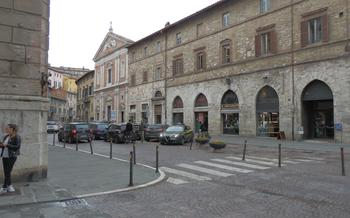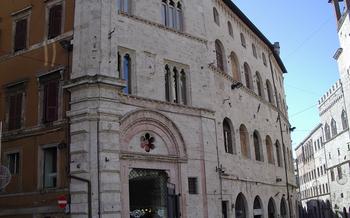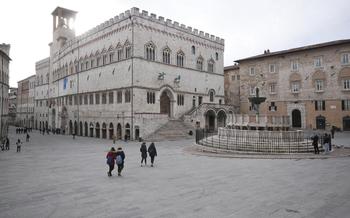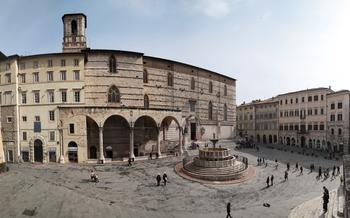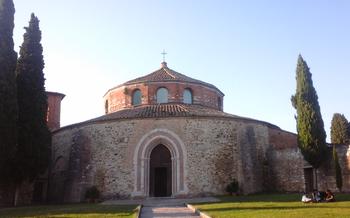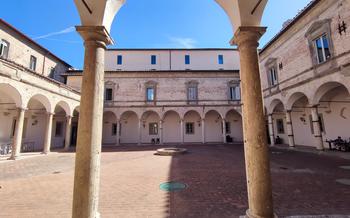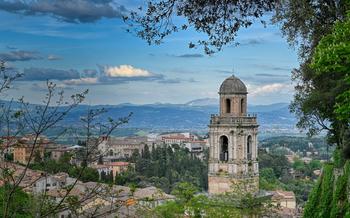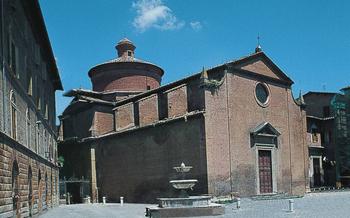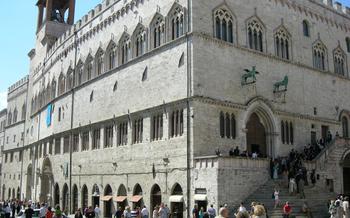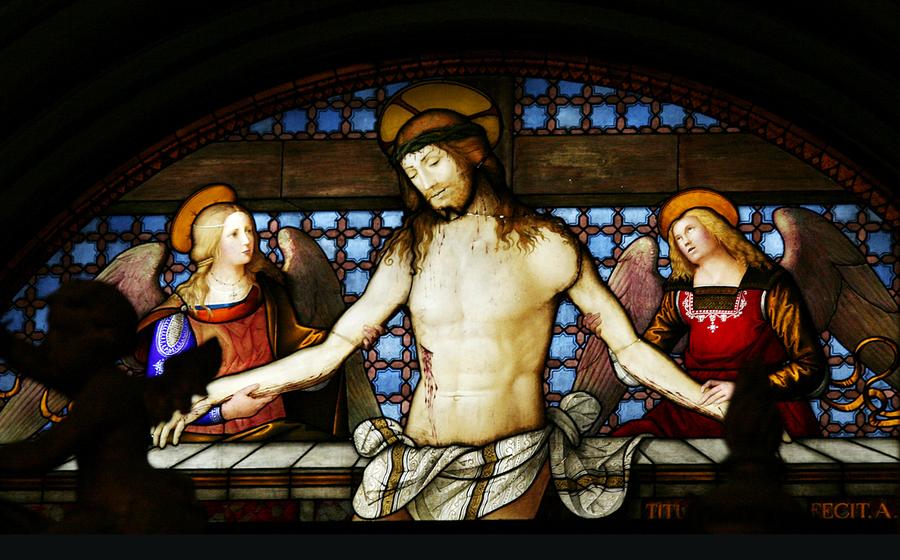
Cathedral of San Lorenzo
- A Stroll through History - Unveiling the Cathedral's Past
- Marvelous Facade - A Symphony in Stone
- Stepping Inside - An Ode to Spirituality
- The Altar's Majesty - A Glimpse of Divine Grandeur
- Exploring the Mysteries of the Crypt
- Splendor of the Bell Tower - A Beacon of Faith
- San Bernardino's Oratory - A Saint's Legacy
- Festivals and Celebrations - A Vibrant Tapestry of Faith:
- Spiritual Significance - A Center of Devotion
- Restoration and Preservation - Ensuring Enduring Grandeur
- The Cathedral Museum - Unveiling Hidden Treasures
- Local Legends and Folklore - Whispers of the Past
- Insider Tip - Unveiling a Secret Gem
A Stroll through History - Unveiling the Cathedral's Past
Perugia's Cathedral of San Lorenzo stands as a testament to the city's rich history, embodying architectural evolution and significant historical events. Its origins can be traced back to the 4th century, with the construction of a small church dedicated to Saint Lawrence. Over time, this church underwent significant transformations, reflecting the changing artistic and religious landscape of the region.
In the 12th century, as Perugia flourished and its population grew, the original church was deemed insufficient to accommodate the growing congregation. Thus, the construction of a new and grander cathedral commenced, incorporating elements of Romanesque and Gothic architectural styles. This ambitious project, undertaken by renowned architects and craftsmen, spanned several decades, resulting in the magnificent edifice we see today.
Throughout its history, the Cathedral of San Lorenzo has witnessed numerous historical events that have shaped Perugia's identity. It has served as a venue for important religious ceremonies, political gatherings, and cultural events. The cathedral has also endured its share of trials, including fires, earthquakes, and restorations, each leaving its mark on its architectural fabric.
Exploring the cathedral's past is an enriching journey that transports visitors to different eras, allowing them to appreciate the layers of history and artistry that have shaped this iconic landmark.
Marvelous Facade - A Symphony in Stone
The facade of the Cathedral of San Lorenzo is a captivating blend of Romanesque and Gothic architectural styles. Intricate carvings and sculptures adorn every inch of the stone exterior, creating a mesmerizing symphony in stone. The main portal features a series of bas-reliefs depicting scenes from the Bible, while the upper section showcases a graceful rose window surrounded by delicate tracery.
One of the most striking features of the facade is the abundance of symbolic representations. The griffins and lions carved into the stone symbolize strength and courage, while the doves represent peace and purity. The intricate knots and interlacing patterns evoke the interconnectedness of all things.
At the very top of the facade, a majestic statue of St. Lawrence, the cathedral's patron saint, stands proudly. With his arms outstretched, he seems to welcome visitors and pilgrims alike, inviting them to step into the sacred space within.
Stepping Inside - An Ode to Spirituality
As you cross the threshold of the Cathedral of San Lorenzo, you are enveloped by a sense of awe and reverence. The interior of the cathedral is a testament to the artistry and devotion of its creators. The spacious nave, with its soaring columns and intricate ceiling frescoes, draws your gaze upward, inviting contemplation and reflection.
The ceiling is a masterpiece in itself, adorned with vibrant frescoes that depict scenes from the Bible and the lives of saints. Each brushstroke tells a story, capturing moments of inspiration, faith, and devotion. The walls are adorned with stunning artworks, each with its own unique narrative. From delicate sculptures to intricate mosaics, every detail contributes to the cathedral's rich tapestry of artistic expression.
Among the most notable artworks is the magnificent altarpiece, a masterpiece of Renaissance craftsmanship. Its intricate carvings and vibrant colors depict scenes from the life of Christ, inviting visitors to reflect on his teachings and sacrifice. Another highlight is the Chapel of Sant'Onofrio, which houses a beautiful fresco by the renowned Umbrian artist, Perugino. The fresco depicts the Madonna and Child, surrounded by a chorus of angels, and is a testament to Perugino's mastery of light and composition.
In every corner of the cathedral, there is something to discover, each element contributing to the sacred atmosphere that permeates the space. As you wander through the nave, you can't help but feel a sense of connection to the past, to the countless pilgrims and worshippers who have walked these same aisles, seeking solace, guidance, and inspiration.
The Altar's Majesty - A Glimpse of Divine Grandeur
The altar of the Cathedral of San Lorenzo is a masterpiece that commands attention with its intricate design and profound symbolism. Crafted with meticulous precision, the altar exudes an aura of sacredness and divine grandeur. Its elaborate carvings depict scenes from the life of Christ and the saints, inviting the faithful to contemplate the mysteries of faith. The centerpiece of the altar is the majestic altarpiece, a testament to the artistry and devotion of its creators. With its vibrant colors and lifelike figures, the altarpiece transports the viewer to another realm, inspiring awe and wonder.
The altar also holds immense historical significance. It is believed to have been commissioned by Pope Innocent III in the 13th century and has witnessed countless religious ceremonies, prayers, and confessions throughout the ages. The altar has undergone several renovations over the centuries, each reflecting the changing artistic styles and devotional practices of the time. Despite these changes, the altar has retained its original essence, serving as a sacred space where the community gathers to celebrate their faith.
One of the most captivating features of the altar is its exquisite craftsmanship. The intricate carvings and delicate details reveal the painstaking efforts of master artisans who dedicated their lives to creating this masterpiece. The altar's surface is adorned with bas-reliefs, sculptures, and precious stones, each element contributing to the overall splendor of the design. The harmonious blend of materials, including marble, gold, and enamel, creates a visually stunning effect that leaves visitors spellbound.
Exploring the Mysteries of the Crypt
Beneath the awe-inspiring Cathedral of San Lorenzo lies a hidden treasure – the crypt. Descend into this ancient subterranean realm, where time seems to stand still, and discover a world steeped in mystery and intrigue. The crypt's origins are shrouded in the mists of time, dating back to the early days of Christianity when it served as a place of refuge and worship for persecuted believers.
As you cautiously tread the worn stone steps, a palpable sense of history envelops you. The crypt's dimly lit corridors reveal ancient frescoes and intricate carvings that narrate tales of saints and martyrs who once graced these hallowed grounds. Among the most captivating discoveries are the remnants of a Roman cistern, a testament to the city's rich past.
The crypt is also home to several tombs and burial chambers, where prominent figures from Perugia's history rest in eternal slumber. Elaborate sarcophagi adorned with intricate carvings and inscriptions whisper stories of their occupants' lives and legacies. The air here is heavy with a mix of reverence and intrigue, as if the spirits of those who have passed still linger within these ancient walls.
Venturing into the crypt is like embarking on a journey through time, where the past and present intertwine. It is a place of quiet contemplation and introspection, inviting visitors to connect with the spiritual essence of this sacred space. As you emerge from the crypt, you will carry with you a sense of awe and wonder, forever changed by this subterranean encounter.
Splendor of the Bell Tower - A Beacon of Faith
Gracefully ascending beside the Cathedral of San Lorenzo, the bell tower stands as a symbol of faith and a testament to architectural ingenuity. Its commanding presence dominates the city skyline, inviting visitors to embark on a journey of history and spirituality.
Constructed in the 13th century, the bell tower showcases a harmonious blend of Romanesque and Gothic styles. Its sturdy base features intricate carvings and bas-reliefs, narrating stories from the Bible and the lives of saints. As one's gaze travels upward, the tower's design gradually transitions into a lighter, more delicate Gothic style. Slender windows and ornate pinnacles adorn the upper levels, creating an effect of lightness and aspiration.
Inside the tower, a spiral staircase winds its way to the top, offering visitors a chance to climb to the viewing platform. The effort is rewarded with breathtaking panoramic views of Perugia and its picturesque surroundings. From this vantage point, one can admire the city's terracotta rooftops, the rolling hills of Umbria, and the distant Apennines.
Historically, the bell tower served as a watchtower, with sentinels keeping a vigilant eye over the city and its environs. Its strategic position allowed for early detection of approaching enemies or fires, enabling the city to respond swiftly to threats. The bell tower's bells, too, played a crucial role in daily life, marking the hours, summoning the faithful to prayer, and alerting the community to important events.
San Bernardino's Oratory - A Saint's Legacy
Amidst the architectural wonders of Perugia, the San Bernardino's Oratory stands as a testament to the city's deep-rooted spiritual heritage. Dedicated to the renowned Franciscan saint, Bernardino of Siena, this oratory exudes an aura of tranquility and devotion.
Constructed in the 15th century, the oratory showcases a harmonious blend of Gothic and Renaissance styles. Its elegant facade, adorned with intricate carvings and delicate tracery, beckons visitors to step inside and explore the sanctuary within.
Inside, the oratory's serene atmosphere envelops the senses. The soft glow of natural light filtering through stained-glass windows illuminates the simple yet elegant interior. The walls are adorned with vibrant frescoes depicting scenes from the life of Saint Bernardino, narrating his journey from humble beginnings to sainthood.
Pilgrims and visitors alike are drawn to this sacred space, seeking solace and inspiration. The oratory's profound connection to Saint Bernardino, whose teachings and miracles left an indelible mark on Perugia, makes it a place of great spiritual significance.
Festivals and Celebrations - A Vibrant Tapestry of Faith:
Throughout the year, the Cathedral of San Lorenzo serves as a stage for a captivating array of religious festivals and processions. These events are a testament to the enduring faith and devotion that permeate the city of Perugia. The most notable celebration is the Calendimaggio, a springtime festival that pays homage to the city's patron saint, Saint Herculanus. During this joyous occasion, the streets come alive with vibrant parades, costumed performers, and traditional music, creating an atmosphere of revelry and devotion.
One of the most awe-inspiring spectacles is the Procession of the Ceri, held annually on May 15th. Three enormous candles, adorned with intricate decorations and representing the city's three patron saints, are carried through the streets in a display of unity and devotion. The procession is accompanied by a sea of faithful followers, their voices raised in prayer and song, creating a truly unforgettable experience.
These festivals are not merely religious events; they are a vibrant expression of Perugia's cultural heritage and community spirit. They offer visitors a unique opportunity to witness the city's deep-rooted traditions and experience the fervor and passion that define its people. Immerse yourself in the vibrant tapestry of faith that unfolds within the walls of the Cathedral of San Lorenzo and discover the essence of Perugia's spiritual heritage.
Spiritual Significance - A Center of Devotion
The Cathedral of San Lorenzo holds immense spiritual significance, serving as a hub for religious devotion and a symbol of Christian faith in Perugia. Throughout history, it has been a site of important religious ceremonies, pilgrimages, and processions, drawing believers from across the region. The cathedral's grand interior, adorned with intricate frescoes and sacred artworks, creates an atmosphere of reverence and awe, inspiring countless worshippers and pilgrims.
As the seat of the Archdiocese of Perugia, the cathedral has played a crucial role in the spiritual life of the city and the surrounding area. It has witnessed countless baptisms, weddings, and funerals, marking significant moments in the lives of local residents. Over the centuries, the cathedral has become an integral part of the community, serving as a place of solace, reflection, and spiritual connection for generations.
Beyond its religious significance, the Cathedral of San Lorenzo represents the unity and identity of the city of Perugia. Its prominent position in the heart of the historic center makes it a symbol of the city's rich cultural and spiritual heritage. The cathedral's enduring presence has witnessed the city's triumphs and tribulations, becoming an enduring symbol of faith, resilience, and community spirit.
Restoration and Preservation - Ensuring Enduring Grandeur
The Cathedral of San Lorenzo has undergone several restoration projects throughout its history, a testament to its enduring significance and the unwavering commitment to preserving its beauty. These efforts have played a crucial role in maintaining the cathedral's structural integrity and safeguarding its artistic treasures for generations to come.
One of the most comprehensive restorations took place in the 19th century under the direction of architect Luigi Poletti. Poletti meticulously restored the cathedral's exterior, repairing damaged stonework, and reconstructing elements that had been lost over time. He also oversaw the restoration of the interior, including the cleaning and restoration of the frescoes and artwork.
In the 20th century, further restoration work was undertaken to address the damage caused by earthquakes and the passage of time. These projects focused on strengthening the cathedral's foundations, repairing the roof, and restoring the intricate carvings and sculptures on the facade.
The ongoing preservation efforts at the Cathedral of San Lorenzo are a testament to the importance of this sacred edifice to the people of Perugia and beyond. Through these dedicated efforts, the cathedral continues to stand as a beacon of faith and a symbol of the city's rich cultural heritage, ensuring that its grandeur and beauty will be enjoyed for generations to come.
The Cathedral Museum - Unveiling Hidden Treasures
Delve into the heart of the Cathedral of San Lorenzo and discover the secrets enshrined within its walls at the Cathedral Museum. A treasure trove of sacred art and artifacts awaits, offering a glimpse into the rich history and profound spiritual significance of this revered edifice.
Amongst the museum's prized possessions are exquisite paintings, intricate sculptures, and precious liturgical objects, each narrating a chapter in the cathedral's storied past. Admire the delicate brushstrokes of Renaissance masters, marvel at the lifelike expressions captured in carved figures, and gain insights into the rituals and traditions that have shaped this sacred space.
The museum also houses a collection of fascinating archaeological findings unearthed during excavations beneath the cathedral. These relics, remnants of ancient civilizations and forgotten eras, provide a tangible connection to the city's deep-rooted history. Discover the foundations upon which Perugia was built and trace the evolution of its sacred traditions through these unearthed treasures.
A visit to the Cathedral Museum is an immersive journey through time, faith, and artistry. Here, you'll uncover the hidden stories that have shaped the soul of Perugia, leaving you with a profound appreciation for the enduring legacy of the Cathedral of San Lorenzo.
Local Legends and Folklore - Whispers of the Past
Throughout the centuries, the Cathedral of San Lorenzo and its surroundings have become intertwined with local legends and folklore, painting a vivid tapestry of tales that enhance its mystical aura. One captivating myth speaks of a secret tunnel connecting the cathedral to the nearby Palazzo dei Priori, the historic town hall. Legend has it that this subterranean passage was once used by the city's rulers to seek refuge during times of turmoil or to discreetly transport treasures between the two buildings. Locals whisper of mysterious figures seen emerging from the tunnel's depths late at night, adding to the cathedral's allure and mystique.
Another intriguing tale revolves around the legendary figure of Braccio da Montone, a renowned military leader who ruled Perugia in the 15th century. According to legend, Braccio was so devoted to the cathedral that he ordered the construction of a magnificent tomb for himself within its walls. However, his ambitious plans were cut short when he was killed in battle. Despite his untimely demise, his spirit is said to roam the cathedral's grounds, forever guarding his beloved city.
These local legends and stories, passed down from generation to generation, breathe life into the stones of the Cathedral of San Lorenzo, transforming it into a living testament to Perugia's rich history and cultural heritage. As visitors explore its sacred spaces, they can't help but feel a sense of wonder and intrigue, drawn into the captivating world of myths, legends, and whispered secrets that surround this awe-inspiring edifice.
Insider Tip - Unveiling a Secret Gem
Beyond its visible grandeur, the Cathedral of San Lorenzo holds a secret that few visitors know about. Hidden beneath the city's bustling streets lies an ancient underground passage that connects the cathedral to the Palazzo dei Priori, the historic town hall of Perugia. This secret tunnel, known as the "Sotterraneo di Perugia," offers a glimpse into the city's rich history and allows visitors to explore a hidden realm beneath the city.
The passageway is believed to date back to the Etruscan period, around the 6th century BC, and was originally used as a water supply route. Over the centuries, it has served various purposes, including as a secret escape route for the city's rulers and as a storage space for valuable goods.
Today, the Sotterraneo di Perugia is open to the public, allowing visitors to embark on a unique and captivating journey through time. Guided tours are available, providing insights into the history and significance of this hidden gem. As you descend into the depths of the city, you'll discover a fascinating world of ancient tunnels, hidden chambers, and intriguing artifacts, offering a glimpse into Perugia's past that few visitors ever get to experience.
Exploring the Sotterraneo di Perugia is like stepping into a secret world, where history comes alive and forgotten stories are revealed. It's a unique opportunity to delve deeper into the heart of Perugia, uncovering the hidden treasures that lie beneath its surface.
